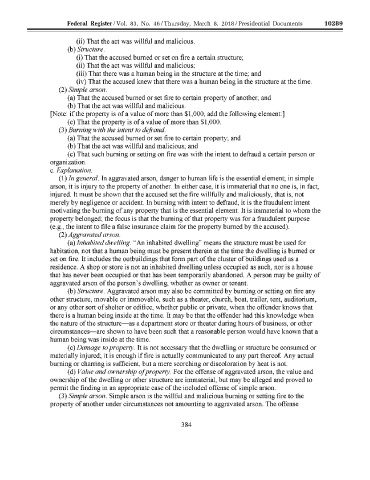Page 586 - Trump Executive Orders 2017-2021
P. 586
Federal Register / Vol. 83, No. 46 / Thursday, March 8, 2018 / Presidential Documents 10289
(ii) That the act was willful and malicious.
(b) Structure.
(i) That the accused burned or set on fire a certain structure;
(ii) That the act was willful and malicious;
(iii) That there was a human being in the structure at the time; and
(iv) That the accused knew that there was a human being in the structure at the time.
(2) Simple arson.
(a) That the accused burned or set fire to certain property of another; and
(b) That the act was willful and malicious.
[Note: if the property is of a value of more than $1,000, add the following element]
(c) That the property is of a value of more than $1,000.
(3) Burning with the intent to defraud.
(a) That the accused burned or set fire to certain property; and
(b) That the act was willful and malicious; and
(c) That such burning or setting on fire was with the intent to defraud a certain person or
organization.
c. Fxplanalion.
(1) ln general. In aggravated arson, danger to human life is the essential element; in simple
arson, it is injury to the property of another. In either case, it is immaterial that no one is, in fact,
injured. It must be shown that the accused set the fire willfully and maliciously, that is, not
merely by negligence or accident. In burning with intent to defraud, it is the fraudulent intent
motivating the burning of any property that is the essential element. It is immaterial to whom the
property belonged; the focus is that the burning of that property was for a fraudulent purpose
(e.g., the intent to file a false insurance claim for the property burned by the accused).
(2) Aggravated arson.
(a) inhabited dwelling. "An inhabited dwelling" means the structure must be used for
habitation, not that a human being must be present therein at the time the dwelling is burned or
set on fire. It includes the outbuildings that form part of the cluster of buildings used as a
residence. A shop or store is not an inhabited dwelling unless occupied as such, nor is a house
that has never been occupied or that has been temporarily abandoned. A person may be guilty of
aggravated arson of the person's dwelling, whether as owner or tenant.
(b) Structure. Aggravated arson may also be committed by burning or setting on fire any
other structure, movable or immovable, such as a theater, church, boat, trailer, tent, auditorium,
or any other sort of shelter or edifice, whether public or private, when the offender knows that
there is a human being inside at the time. It may be that the offender had this knowledge when
the nature of the structure-as a department store or theater during hours of business, or other
circumstances-are shown to have been such that a reasonable person would have known that a
human being was inside at the time.
(c) Damage to property. It is not necessary that the dwelling or structure be consumed or
materially injured; it is enough if fire is actually communicated to any part thereof. Any actual
burning or charring is sufficient, but a mere scorching or discoloration by heat is not.
(d) Value and ownership of property. For the offense of aggravated arson, the value and
ownership of the dwelling or other structure are immaterial, but may be alleged and proved to
permit the finding in an appropriate case of the included offense of simple arson.
(3) Simple arson. Simple arson is the willful and malicious burning or setting fire to the
sradovich on DSK3GMQ082PROD with PRES DOCS VerDate Sep<11>2014 18:39 Mar 07, 2018 Jkt 244001 PO 00000 Frm 00403 Fmt 4705 Sfmt 4790 E:\FR\FM\08MRE0.SGM 08MRE0 ER08MR18.405</GPH>
property of another under circumstances not amounting to aggravated arson. The offense
384

